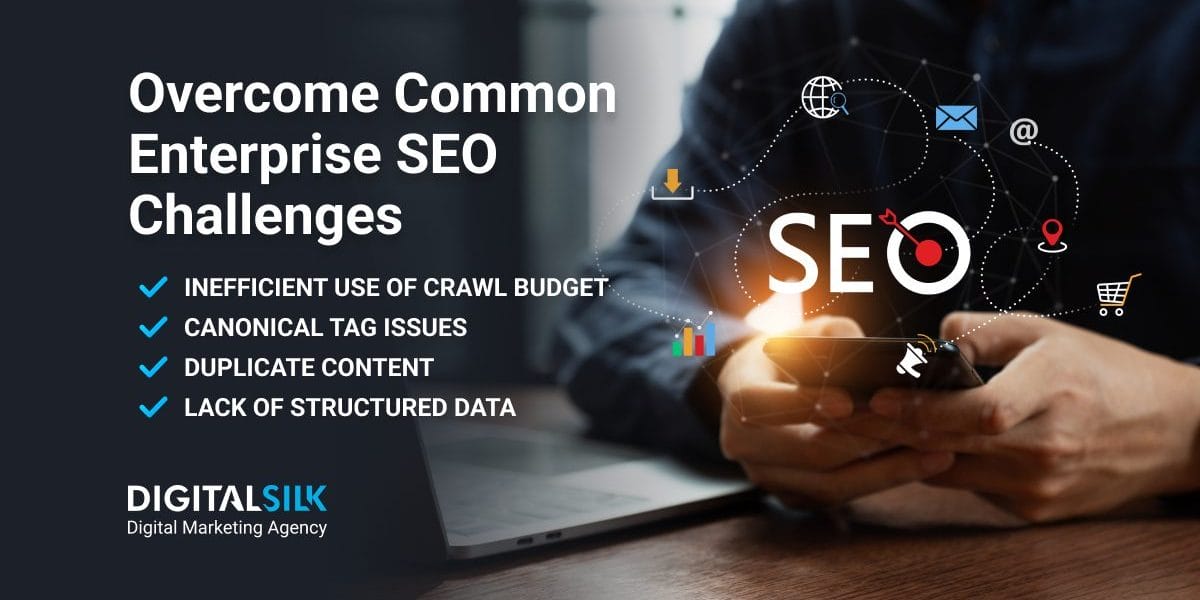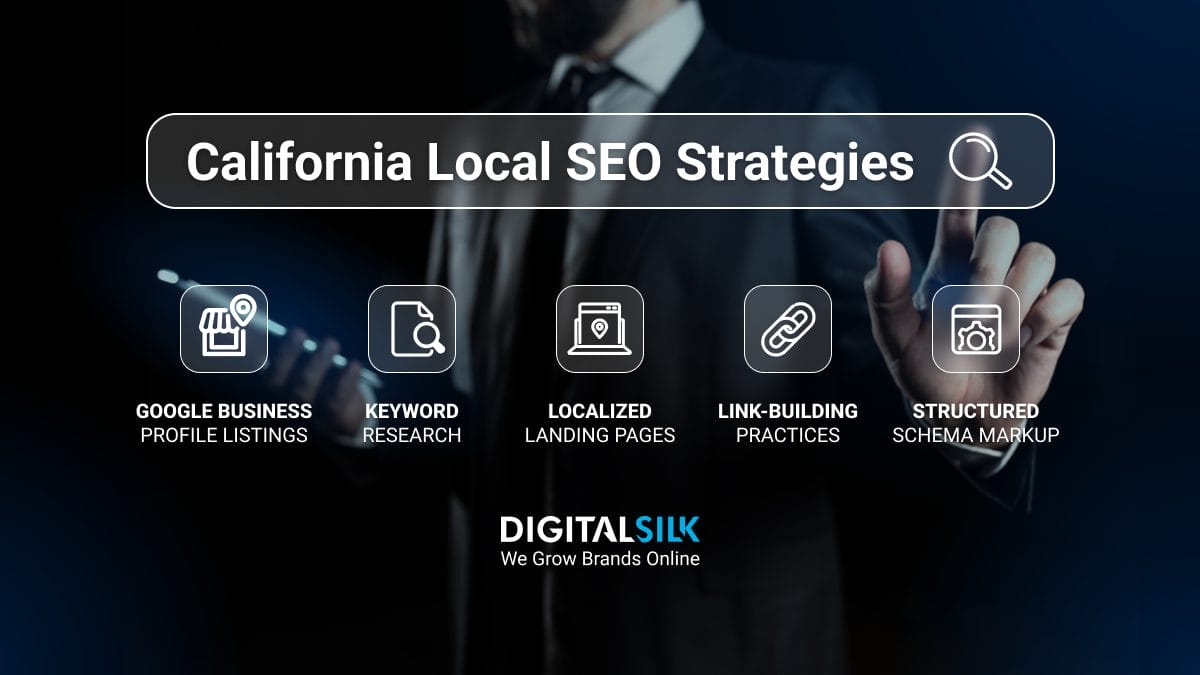Enterprise SEO Solutions: Key Highlights
-
Tie SEO to business goals: Rankings and traffic only matter if they drive revenue, conversions or growth.
-
Prioritize for impact: Focus on the fixes that directly support business outcomes, not just what audits flag.
-
Structure affects performance: lean architecture and crawl efficiency are key to search visibility and user engagement.
Search visibility isn’t lost to competitors — it’s lost to internal friction, overlooked systems and slow decisions.
When you’re managing thousands of pages across siloed teams and outdated systems, small issues turn into systemic traffic loss.
49% of the time, the top-ranking page wins the most traffic, which means even minor technical gaps can quietly cost millions.
In this post, we’ll explore 15 critical enterprise SEO solutions to common challenges to help you transform your large-scale website into a search-optimized revenue driver.
1. Mismatch Between SEO Tactics And Goals
What happens when your SEO team celebrates climbing to position one for a keyword while your conversion rates remain flat?
You’re witnessing the classic enterprise disconnect between SEO tactics and business objectives.
What This Challenge Looks Like
Organic search drives 53% of website traffic, yet too often that volume fails to convert into meaningful outcomes.
For enterprise organizations, the issue isn’t a lack of activity — it’s the absence of clarity around what that activity is supposed to achieve.
You should pay attention to the following enterprise SEO mistakes:
- The wrong metrics get too much attention: It’s easy to celebrate higher rankings or more traffic, but unless those gains tie directly to revenue, market share or engagement, they’re noise.
- Teams work in isolation: SEO operates in a silo, disconnected from product, sales and brand strategy. Without shared priorities, even the best execution can feel irrelevant.
- Strategy gets recycled: Off-the-shelf SEO tactics rarely account for the nuances of your business, whether it’s your sales cycle, customer behavior or market position.
How To Align SEO With Business Goals
Instead of asking what you want to rank for, ask what business outcome you’re trying to influence — and work backward from there.
Here’s how to create alignment that lasts:
- Define success in business terms first: Rankings and traffic matter, but only as indicators of progress toward larger goals.
- Set SMART objectives: Specific, Measurable, Achievable, Relevant and Time-Bound (SMART) goals should link search performance to specific business outcomes.
- Prioritize by business value: Don’t waste time fixing every technical issue — start with the changes that can move the needle.
- Build cross-functional visibility: Make sure SEO isn’t working in a vacuum by setting up consistent communication between teams.
For instance, Digital Silk’s client Puma Energy had a website that wasn’t optimized for search, leading to poor organic traffic and limited brand visibility.
Our team addressed this disconnect by implementing comprehensive SEO and redesigning the site around tailored user journeys.
The result: a 63% increase in engagement and a 27% rise in visitors — proof that aligning SEO with business goals drives measurable impact.
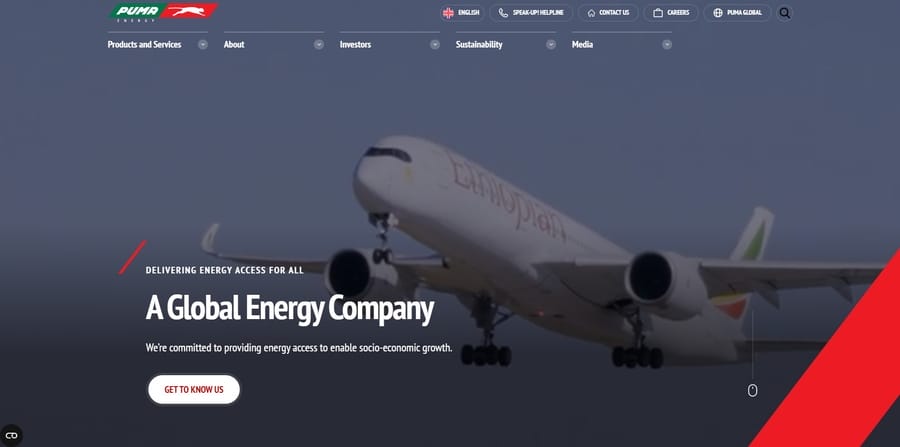
2. Inefficient Use Of Crawl Budget
Search engines allocate a limited crawl budget and when it’s spent inefficiently, high-value pages can sit unnoticed while less relevant ones consume attention.
What This Challenge Looks Like
The challenge isn’t that your site lacks quality content — it’s that search engines may never see it.
If Googlebot is only crawling a fraction of your pages each day, updates to high-priority content can sit in the dark while low-value URLs consume the bulk of attention.
You’ll often see corporate enterprise SEO mistakes like:
- Parameter-filled URLs dominating crawl logs with no strategic value
- Redirect chains that tie up crawl capacity without adding clarity or relevance
- Repeated crawling of outdated content while new, revenue-focused pages aren’t discovered
- Server lag during crawl peaks, slowing delivery of important resources
- High-volume soft 404s indicating wasted effort on nonexistent or low-priority pages
How To Maximize Your Crawl Budget
The market for SEO services is expected to grow at a compound annual rate of 18.3% in 2025, reaching $10.69 billion.
This surge reflects the increasing pressure on enterprises to make smarter use of every technical advantage — including how efficiently they’re indexed.
Use Google Search Console’s crawl stats to understand how search engines interact with your site — pages are being accessed, how often, and where crawl efforts are being wasted.
Once you’ve surfaced the inefficiencies, focus on:
- Audit your content publishing cadence: Stagger releases of new content to prevent flooding crawlers with large volumes at once, which can delay indexing of key assets.
- Segment content by priority: Assign clear value tiers across your content types so crawl strategies focus first on revenue-generating or time-sensitive material.
- Use server-side signals intentionally: Header directives like Last-Modified and Cache-Control can influence how frequently search engines revisit pages, improving efficiency across large catalogs.
- Monitor crawl volatility: Watch for unusual spikes or drops in crawl activity using server logs and analytics, which may indicate wasted crawler cycles or unseen barriers.
3. Canonical Tag Issues
Canonical tags guide search engines to the right version of a page, helping consolidate signals and ensure the correct URL is indexed.
On large websites, inconsistent or misapplied canonicals quietly undermine visibility and cause search engines to prioritize the wrong pages.
What This Challenge Looks Like
The problem isn’t the presence of similar pages — it’s the lack of clear signals guiding search engines toward the intended version.
Common causes include:
- Tracking parameters that generate multiple URL variations
- Filtered or faceted navigation creating URL sprawl in product catalogs
- Content reused across subdomains or regional sites without cross-domain canonicals
- Indexable staging or development environments conflicting with live content
- CMS configurations that auto-populate canonicals incorrectly, often ignoring context
Best Practices For Canonicalization
Canonical tags should be treated as directional infrastructure — part of a broader indexing strategy that aligns with your business priorities.
Here’s how to get more value from your canonical strategy:
- Use absolute URLs with full protocol references (https://) to remove ambiguity
- Place tags in the <head> section of your HTML where they’re reliably recognized
- Avoid canonical chains — tags should always point directly to the final, preferred URL
- Use self-referencing canonicals on primary pages to confirm their authority
- Align across systems — ensure sitemaps, internal links and redirects all point to the canonical version
Example structure:
- Canonical URL: https://example.com/blog/
- Variant URL: https://example.com/blog/?page=1
- Tag format: <link rel=”canonical” href=”https://example.com/blog/” />
You can define canonicals using the Yoast SEO plugin.
Go to the Yoast options on any page or post, expand the Advanced tab and enter your canonical URL in the Canonical URL field.
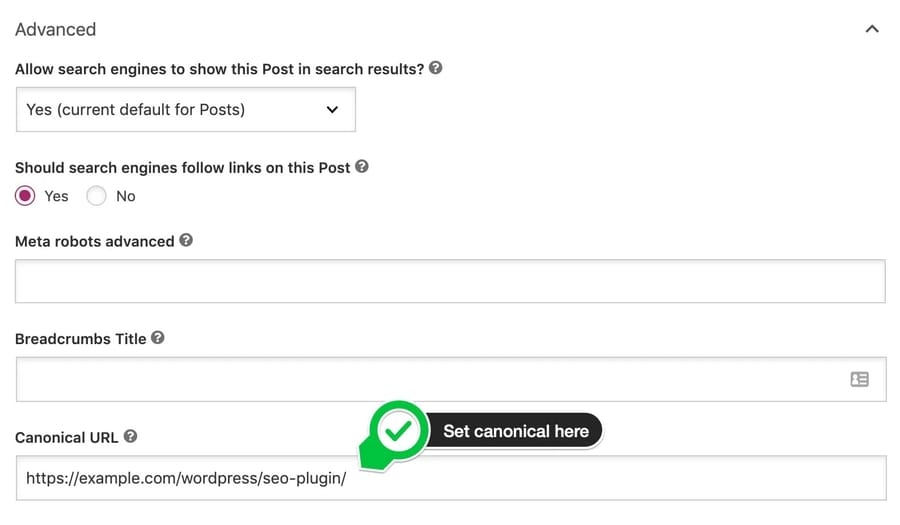
4. Pagination Problems
Pagination often gets treated as a backend formatting issue, but on enterprise websites, it directly influences how — and whether — search engines access deeper content.
What This Challenge Looks Like
Many large sites see little to no organic traffic beyond the first few product or article listings.
In most cases, the underlying issue is how pagination has been implemented.
Common difficulties with enterprise SEO include:
- Content discovery barriers: JavaScript-based infinite scroll or “Load More” features can work well for users, but they often block search engines from accessing anything beyond the initial view.
- Ranking inefficiencies: Paginated series often share similar templates with minor content differences. Without proper structure, search engines struggle to determine which pages hold the most relevance.
- Crawl inefficiency: Poor pagination design forces search engines to follow page-by-page paths through vast sequences, reducing their ability to reach deeper, more valuable entries.
- Signal miscommunication: Sites that point all canonical tags to page one unintentionally devalue content beyond the first view, making it less likely to appear in search results.
How To Implement SEO-Friendly Pagination
Good pagination does more than serve SEO — it also improves navigation, which 38% of users say is their first impression of a site.
Unlike infinite scroll or dynamic “Load More” elements, traditional pagination can be structured to serve both audiences effectively.
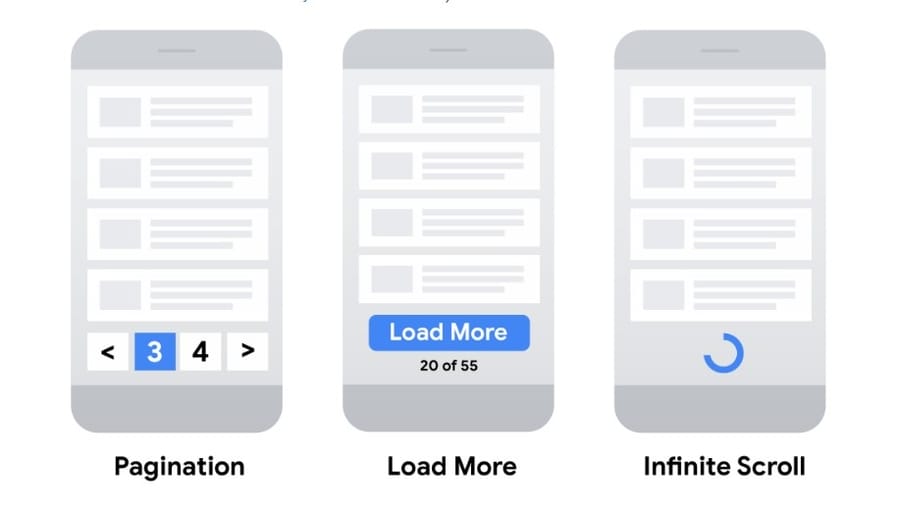
You can implement the following SEO solutions:
- Use consistent, crawlable URL structures. Whether using query strings (/products?page=2) or folder paths (/products/page/2), ensure all pagination URLs follow a predictable format that search engines can index.
- Apply self-referencing canonical tags: Each pagination page should point to itself — not to the first page — to signal that its content is distinct and valuable.
- Implement HTML-based navigation: Use actual anchor links (<a href=”…”>) instead of JavaScript triggers. This allows search engines to crawl sequential pages reliably.
- Add “skip to” links for deep pagination: Enabling direct jumps to later pages (e.g. page 10, 20 or 30) helps search engines bypass shallow sequences and index deeper content faster.
- Avoid no-index directives on paginated pages: Doing so blocks discovery of the content they contain, reducing the overall reach and relevance of your domain.
5. Duplicate Content Across Pages
Duplicate content isn’t always the result of negligence — it’s often the byproduct of well-intentioned teams working in parallel without shared oversight.
What This Challenge Looks Like
When multiple URLs contain overlapping or identical copy, search engines are forced to choose which version to rank — often without aligning to your business priorities.
This results in several enterprise SEO mistakes:
- Diluted authority: Instead of reinforcing one strong page, signals are split across several weaker ones.
- Misused crawl time: Search engines spend time reprocessing similar pages instead of reaching new or strategic ones.
- Reduced visibility: Duplicate or near-duplicate pages are filtered out, pushing relevant content lower in results.
- Increased internal competition: Pages unintentionally target the same queries, undermining your own efforts from within.
How To Detect And Fix Duplicate Content
A unified content strategy remains one of the most effective ways to drive search performance.
In fact, 16.7% of SEO experts point to overall content strategy as the most impactful SEO approach.
To identify duplication:
- Review Google Search Console for issues like “Duplicate without user-selected canonical”
- Use crawl tools like Screaming Frog to flag pages with identical titles, headers or meta descriptions
- Scan for external reuse using tools like Copyscape to uncover duplication across domains
- Evaluate AI-generated content risks with tools like Copyleaks AI Content Detector or Quillbot’s AI Detector to ensure originality across editorial workflows
To resolve these difficulties with enterprise SEO:
- Use 301 redirects to consolidate authority under the preferred page
- Rewrite overlapping content with a focus on value differentiation
- Apply relevant tags to clarify intent when consolidating isn’t feasible
- Maintain a centralized content log to track publication activity across departments and reduce duplication at the source
6. Poor Website Architecture
If your site’s structure makes it hard for users or search engines to find what matters, you’re disrupting discoverability, devaluing important content and turning navigation into a guessing game.
What This Challenge Looks Like
When structure breaks down, search engines stop understanding how your content fits together — and users stop trying. Both behaviors erode long-term performance.
Common signs include:
- Orphaned pages with no internal links, making them nearly impossible to surface
- Deep click paths that bury key content five or six layers down
- Inconsistent URL structures that confuse indexing and fragment search signals
- Navigation dead ends where users hit a page with no next step
88% of users are less likely to return after a poor experience. That’s not just a design issue — it reflects a failure to structure information in a way that meets expectations and supports discovery.
How To Improve Site Architecture
Map your current structure to understand how content is grouped, how pages connect and where the friction lies.
From there you can use the following enterprise SEO solutions:
- Build a logical hierarchy: Start from the homepage, then organize into categories, subcategories and individual content pages.
- Align URLs with structure: Use clean, readable paths like: example.com/category/subcategory/product-name
- Strengthen internal linking: Create cross-links between related content so users and search engines can find multiple paths to the same destination.
- Use breadcrumb navigation: This includes both orientation and crawlability. For example: Home > Category > Subcategory > Product
- Conduct quarterly architecture audits: As your content footprint grows, regularly assess how new pages fit into the system and whether structural clarity is being maintained.
Our client, ABC Senior Services, struggled with disorganized content and a confusing site structure that made it hard for users to find key information.
Digital Silk redesigned the website with simplified navigation and a clear content hierarchy, leading to a 118% increase in user sessions, nearly 1 million Google impressions and a 9.8% drop in bounce rate — proving that structure directly impacts discoverability and engagement.
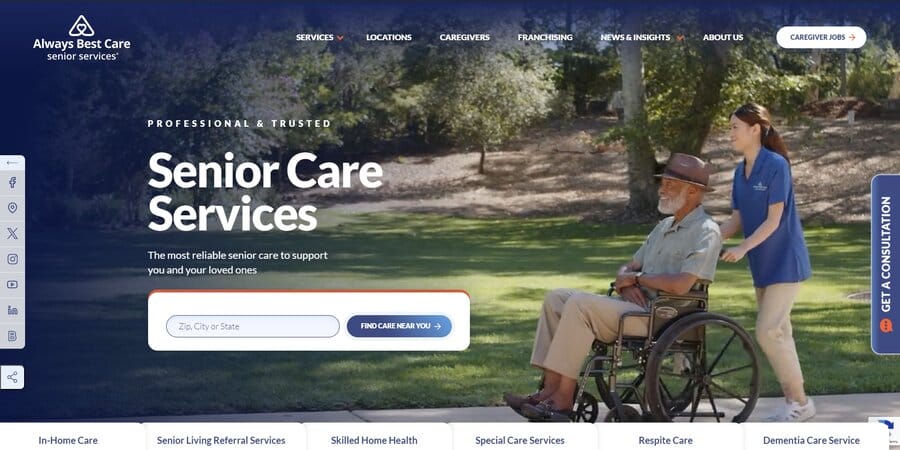
7. Lack Of Prioritization
Without a clear framework, SEO efforts often become scattered.
Teams get caught up fixing whatever’s surfaced by the latest audit, regardless of whether it drives meaningful business results.
What This Challenge Looks Like
When prioritization is missing, several patterns emerge:
- Teams react to alerts instead of working toward strategic goals
- Decisions are based on volume — fixing what shows up most often in reports, rather than what impacts revenue
- Technical fixes take precedence over initiatives that influence market share, visibility or conversions
- Stakeholder requests interrupt planned work, derailing roadmaps and slowing down execution
Over time, this lack of focus weakens results. SEO teams struggle to prove value, organizational support fades and high-impact opportunities are left on the table.
How To Prioritize SEO Tasks Effectively
Effective prioritization links every task to a business outcome.
If a fix doesn’t support growth, conversions or visibility on high-value pages, it shouldn’t rise to the top of the queue.
58.7% of professionals have reported measurable changes in ROI after prioritizing revenue-focused SEO.
The shift comes from using structured frameworks that balance speed with strategic clarity:
- Use an impact-effort matrix to identify high-impact, low-effort opportunities worth tackling first
- Apply the RICE framework to score tasks based on reach, expected impact and required effort
- Rely on the Eisenhower Matrix to distinguish between urgent and important work so that high-value items don’t get delayed by noise
8. Scalability And Resource Constraints
Even with clear priorities in place, implementation at scale often becomes the real roadblock.
Coordinating SEO across thousands of pages, multiple teams and systems introduces complexity that planning alone doesn’t solve.
What This Challenge Looks Like
In many organizations, the SEO lead is spread thin across too many properties, with little operational support and no clear path to scale recommendations.
Budget limitations remain the top concern for 19.4% of professionals, while 9.3% cite scaling processes as their primary challenge — both symptoms of a larger resourcing problem.
Execution often slows down when marketing budgets favor paid channels for their immediacy, or when projects require alignment across six or more departments.
Solutions For Scaling SEO
Scaling SEO isn’t about working harder — it’s about creating systems that allow teams to move efficiently without losing sight of quality or intent.
- Fix issues at the pattern level by focusing on templates that control entire sections of the site, allowing you to roll out improvements across hundreds or thousands of pages in a single effort.
- Automate monitoring and reporting to reduce manual oversight and ensure that performance trends, errors and gaps are surfaced early across your entire domain.
- Use structured content frameworks such as topic clusters and standardized templates to help teams produce content at scale while staying aligned on messaging and technical requirements.
- Establish centralized SEO governance with a small team that sets direction and works through designated liaisons in other departments to streamline execution and avoid conflicting efforts.
9. Technical SEO Issues
In large organizations, technical SEO is often treated as a one-time setup — but it’s the infrastructure that keeps everything else working.
What This Challenge Looks Like
Without ongoing oversight, technical issues quietly build up across CMS platforms, subdomains and content templates.
By the time performance drops or rankings slip, the root cause is buried under layers of accumulated technical debt.
Common technical enterprise SEO challenges include:
- SSL configuration gaps that trigger browser warnings and diminish user trust
- JavaScript-heavy functionality that search engines struggle to render or index reliably
- Inconsistent data across platforms so crawlers can’t understand page context
- Redirect chains that introduce unnecessary delays and reduce crawl efficiency
- Lack of structured data that limits visibility in rich results and hinders content differentiation
How To Fix Technical SEO Problems
Addressing technical SEO at scale requires more than quarterly audits — it demands systems that surface problems early and frameworks that support consistent resolution.
Focus on the following enterprise SEO solutions:
- Consistent HTTPS implementation across all domains, subdomains and user flows
- Improved JavaScript rendering by simplifying execution paths and testing how Google interprets key templates
- Streamlined page structure and performance tuning to ensure fast load times and minimal friction across all devices
- Routine technical audits every six months, paired with real-time monitoring to track emerging issues as your site evolves
| Focus Area | Action |
| HTTPS Coverage | Enforce secure protocols across all domains |
| JavaScript Handling | Simlify execution and confirm crawler access to key points |
| Site Structure & Speed | Optimize layout and performance for fast, consistent page load times |
| Audits & Monitoring | Schedule recurring revews and use tools to catch emerging issues |
10. Slow Page Speed
Slow-loading pages reduce visibility, lower conversion rates and waste crawl budget — especially when delays affect thousands of URLs.
What This Challenge Looks Like
The average website loads its main content in 1.3 seconds, yet enterprise sites often exceed that benchmark due to bloated codebases, oversized media files and legacy scripts layered over time.
Common drivers of performance loss include:
- Uncompressed or improperly sized images
- Excessive third-party tracking and marketing scripts
- Inefficient code execution, particularly in older CMS templates
- Lack of caching and insufficient content distribution infrastructure
- Inconsistent hosting environments that underdeliver under pressure
Googlebot allocates crawl time based on perceived performance, meaning slow pages may be crawled less frequently or missed altogether.
How To Improve Page Speed
Improving site speed is one of the highest-yield investments in large-scale SEO and user experience.
These actions have the most measurable impact:
- Optimize visual assets by compressing images and using modern formats
- Use a Content Delivery Network (CDN) to serve your content from global edge locations, reducing latency
- Enable browser caching so returning users aren’t forced to reload static elements
- Reduce HTTP requests by bundling and minifying CSS and JavaScript resources
- Upgrade your infrastructure with dedicated hosting that can handle scale, load balancing and peak traffic without slowing down
To identify performance bottlenecks, use tools like Google PageSpeed Insights or GTmetrix for individual pages.
For bulk analysis across many URLs, options like Ralf Van Veen’s Bulk PageSpeed tool or Ahrefs Site Audit — though the latter requires a PageSpeed API key — can offer deeper insights at scale.
11. Lack Of Structured Data
Structured data or schema markup gives search engines a clearer understanding of your content, allowing them to surface it in more visible and engaging ways.
Despite its proven impact, structured data often takes a back seat in enterprise SEO programs — though 72.6% of first-page Google results include schema, implementation across large sites is still inconsistent.
What This Challenge Looks Like
When structured data is missing, search engines must interpret pages purely through raw content and markup.
The impact shows up as:
- Lower click-through rates from plain, text-only listings
- Missed visibility in carousels, FAQs or featured snippets
- Weaker presence in voice search, where structured content drives results
- Lost traffic to competitors who offer more informative, interactive listings
How To Implement Schema Markup Effectively
Structured data doesn’t require a full site overhaul — but it does require planning and consistent execution.
While 40% of SEO teams still manage schema manually, many are now shifting to automated solutions using plugins, generators or schema management platforms.
To implement it efficiently:
- Select schema types with business value — Product, FAQ, How-to, Organization and Local Business are most useful across large content sets
- Apply schema at the template level to scale across thousands of pages without requiring individual input
- Validate markup before launch using Google’s Rich Results Test or Schema Markup Validators to avoid deployment errors
- Track structured data performance in Google Search Console to catch implementation issues early and adjust over time
12. Mobile Optimization Gaps
Mobile now accounts for 64.04% of global internet traffic, yet many enterprise sites still treat mobile performance as secondary.
With Google’s full shift to mobile-first indexing, desktop optimization is no longer enough — your rankings, visibility and conversions are now shaped by how your site performs on smaller screens and slower connections.
What This Challenge Looks Like
Mobile issues often stem from decisions made around desktop design that don’t scale down well.
Common mistakes with this SEO strategy include:
- Inconsistent experiences between mobile and desktop versions
- Small or tightly packed tap targets that make navigation difficult
- Content gaps where mobile pages include less information than desktop ones
- Intrusive interstitials that violate Google’s mobile usability guidelines
- Heavy media files and too many HTTP requests that slow load times
How To Optimize For Mobile
Optimizing for mobile includes designing for intent, speed and usability under real-world conditions, with strategies including:
- Use responsive design to ensure consistent structure and consolidate SEO value across devices
- Prioritize Core Web Vitals, especially the Interaction to Next Paint (INP) metric and aim for sub-200ms responsiveness
- Ensure link parity between mobile and desktop versions if you’re running separate HTML structures, particularly at scale
- Increase tap target sizes to 48×48 pixels and avoid placing interactive elements too close together
- Track performance monthly using tools like Google’s PageSpeed Insights to keep pace with evolving mobile standards
Even small gains have measurable upside — cutting just 0.1 seconds from mobile load time can lift conversions by 8.4%.
For enterprise sites handling millions of visits, that difference translates directly into revenue.
13. Missing Or Poor Meta Descriptions
Meta descriptions shape how your brand appears in search results — yet they’re often neglected or auto-generated across enterprise websites.
What This Challenge Looks Like
Despite their importance, meta descriptions are inconsistent across many large sites.
Google rewrites 62.78% of them and 25.02% of top-ranking pages don’t include one at all.
In practice, this leads to:
- Search listings that pull random on-page text, resulting in jumbled or irrelevant messaging
- Duplicated descriptions across URLs so users can’t distinguish one result from another
- Generic phrasing that fails to reflect the content or differentiate your offering
- Messaging that’s out of sync with current products, promotions or brand voice
How To Write Effective Meta Descriptions
Well-crafted meta descriptions don’t improve rankings — but they do influence which listings get clicked, which affects the return on your SEO investments.
To improve performance:
- Stay within optimal length: Keep descriptions between 150–160 characters to avoid truncation and maintain clarity on all devices
- Use language that reflects the user’s intent: Include keywords naturally — not for SEO value, but because matched terms are bolded in results, drawing attention
- Write with purpose: Use active phrasing that previews what the user will gain by clicking, such as “Discover tangible results” or “Explore industry-leading solutions”
14. Broken Internal And External Links
Broken links rarely trigger alarms, but they quietly erode user trust, dilute SEO value and introduce friction at key points in the customer journey.
What This Challenge Looks Like
Broken backlinks account for 66.5% of all links, which directly affects discoverability, rankings and user perception.
Common consequences include:
- Internal links that no longer work, breaking the flow of authority across key pages
- Outdated external references that lead to dead ends or irrelevant content
- Error pages that damage user confidence and increase drop-offs
While Google doesn’t penalize broken links directly, they still flag them as issues — signaling a lack of content upkeep and reducing your ability to compete in search with fully optimized peers.
How To Fix And Monitor Link Health
Managing link health at scale requires both a structured process and focused prioritization.
The most effective fixes are straightforward but high-impact:
- Apply 301 redirects when content moves to preserve both link equity
- Update internal URLs in your CMS, starting with high-traffic and high-ranking pages
- Remove or replace broken outbound links, especially those on conversion-focused content or long-tail resources
15. Reputation Management Challenges
Your brand’s search presence shapes perception long before a prospect visits your website.
What This Challenge Looks Like
Reputation issues surface when unflattering or outdated content appears on page one of branded search queries.
At the enterprise level, the risk scales quickly — 58% of U.S. consumers say a company’s reputation directly impacts their buying decisions and negative headlines tend to overshadow everything else.
When unfavorable content dominates brand searches, the damage extends beyond consumer sentiment.
It impacts:
- Lead quality and conversion rates
- Hiring and retention, especially in competitive talent markets
- Investor perception that shapes early-stage research
- Long-term brand equity, as negative associations appear higher than company-controlled pages
Negative results don’t fade with time. Instead, they occupy valuable space and shift the narrative — whether or not they reflect current reality.
Strategies For Brand SERP Control
Controlling how your brand appears in search requires consistent visibility into what ranks and a proactive plan to influence it.
Focus on:
- Creating high-quality branded content that answers search intent and outperforms older or negative results
- Optimizing owned properties and social profiles to increase their visibility in brand-related queries
- Using technical SEO controls to strengthen the authority of pages you want to surface
- Suppressing negative links by displacing them — targeting page-one visibility with positive assets to push damaging results down
The goal isn’t to erase negative coverage — it’s to ensure it no longer defines the brand experience for people searching with intent.
Avoid Common Enterprise SEO Challenges With Digital Silk
Enterprise SEO success comes from making strategic improvements that compound over time, not from tackling everything at once.
Knowing the common challenges and potential solutions are only the first part of the equation — they need to be supplemented by data-driven strategies and systematic approaches.
Digital Silk’s SEO and digital marketing specialists use the latest best practices and industry insights to deliver results-focused and brand-specific strategies with measurable results.
As a professional web design agency, our services include:
- SEO services
- Digital marketing
- Lead generation
- Paid advertising
- Custom web design
Need help with your SEO strategy?
Contact our team, call us at (800) 206-9413 or fill in the Request a Quote form below to schedule a consultation.
"*" indicates required fields


